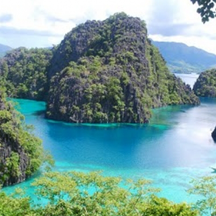By LILYBETH G. ISON
CORON, Palawan — After more than six months since super typhoon “Yolanda” destroyed houses and properties in this island municipality, Mayor Clara “Fems” Reyes said around 4,500 households who are living in coastal areas need to be relocated to ensure their safety.
Reyes said there is also a need to put up public toilets in the entire municipality as there was no toilet even in residential areas.
The local government has identified a possible permanent relocation site in Barangay Bintuan, where there is a 56-hectare government-owned lot for coastal dwellers.

Reyes said they are currently holding talks with various national government agencies, such as the Department of Environment and Natural Resources (DENR), National Housing Authority (NHA), National Anti-Poverty Commission (NAPC) and other stakeholders for the construction of low-cost housing for those to be affected by the plan.
According to the 2010 Philippine census report, this wedge-shaped limestone island has a population of 42,941, of which the major stakeholders are the indigenous people called “Tagbanuas”.
Tagbanua was derived from the words “taga” (people from) and “banwa” (inland area).
Reyes said there is a growing number of local and foreign tourists coming to Coron, proof of which is the increased number of Manila-Busuanga flights daily.
She noted that tourist arrival in 2012 was recorded at 100,000 with only one flight from Manila. Now, it has six flights daily. There are also flights from Cebu, Puerto Princesa and soon from Boracay.
Reyes said that together with the Department of Tourism (DOT), the local government is pushing for more inter-island flights that would directly bring in tourists to Coron without the need for stop-over in Manila.
Coron is one of the Calamianes group of islands. Aside from being an endemic bird habitat, it is also holding distinct assemblages of mammals, reptiles and amphibians. In fact, Coron Island is included in the Palawan Faunal Region as studies indicated its high rate of floral and faunal endemism.
Due to this bio-diverse feature, Coron Island has very high potential for eco-tourism. It is one of the priority areas under the sustainable tourism development of Palawan.
Among the most famous attractions of this first class municipality are the “Hidden Lagoon”, “Twin Peak Coral Garden”, “Kayangan Lake”, and the “Bulungan Beach” which all boast of pristine water and offer scuba divers and snorkel enthusiasts breath taking underwater scenes.
During island hopping, tourists will get to see the spectacular cathedral-shaped rock formations that serve as home to the “balinsasayaw” (swiftlet), which nests from its saliva are made into bird’s nest soup.
The nest can be sold as high as US$ 1,000 per kilogram. Because of its high market value, many Tagbanua tribesmen have died in the process of harvesting the nests, carefully climbing the limestone karst formation and snake their way in between holes to reach the balinsasayaw nests.
There were also report that there were instances the Tagbanuas kill each other for the right to gather this bird’s nest, an ingredient of the delicacy usually offered in Chinese restaurants.
Another attraction of Coron Island is the enchanting “Siete Pecados”, which is nationally acclaimed as the cleanest lake in the Philippines.
“I envision Coron to be the top tourism destination in the country,” said Reyes. As such, she said the local government is crafting a master plan geared toward a sustainable eco-tourism development and become a world-class tourist destination.
Reyes, however, said that to be able to achieve that, Coron needs to undergo a major “facelift”.
Such plan, she said, include the regulation of tourism industry in the island, proper disposal of garbage, strict monitoring of establishments if they are complying with environmental laws.
At present, two establishments — the Sea Dive Center Resort in Barangay Poblacion 3 and the Kristal Langit Lodge in Barangay Poblacion 5 — were slapped with P50,000 fine each due to non-compliance of proper waste management scheme/no septic tank.
Reyes said a joint local government-environment organization teams are continuously conducting inspections of all tourism establishments in Coron to check compliance on their garbage/sewerage disposal system and establishment of septic tanks.
The mayor said there will be no let up in enforcing environmental laws in Coron under her leadership.
“I will not allow the solid-waste management problem to continue. These establishments will be made to comply with environmental laws as well as local ordinances,” she said.
To further boost Coron’s eco-tourism potential, she is encouraging investors to put up tourism-related establishments in the island.
She said there are ongoing talks with concerned government agencies particularly the DENR for the development of the sequestered 22,000-hectare Yulo King Ranch in Coron for the possible establishment of a theme park, big commercial and industrial firms, relocation of government offices, and establishment of residential areas.
“We are currently talking to the DENR to give back to Coron what is ours. Hopefully, if the Yulo King Ranch will be turned over to us (local government), we will be able to develop it,” she said.
Coron is made up mostly of soil that is hardly tillable. Thus, farm crops are limited to mostly cashew trees that can withstand the stony earth.
The island relies mostly on the influx of tourists. Without them, Coron would hardly thrive. (PNA)



 ShareThis
ShareThis